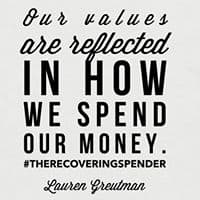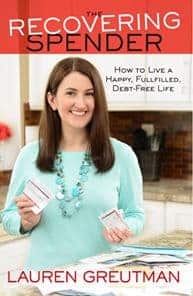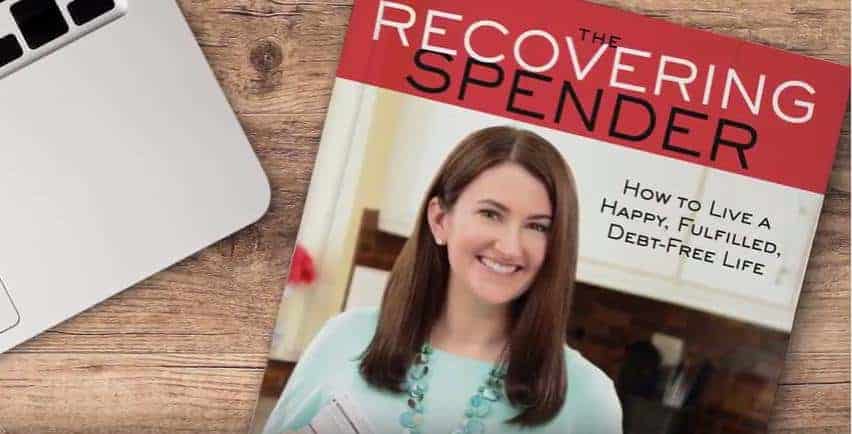Last year I attended a conference for personal finance bloggers in Charlotte, North Carolina. It’s always a good time to meet with others who write about money, and swap a few stories.
One of the more interesting people I met at FinCon, and subsequently talked with on the Money Mastermind Show podcast, was Lauren Greutman.

In her book she tells the story of her family’s turnaround, from $40,000+ in debt, an underwater mortgage and a $1,000 monthly deficit, to the place where they are today – making a good income from owning their own small business.
Her story is a compelling one, so much so that she has become a regular guest on shows like the Today Show, Good Morning America, Fox and Friends, Dr. Oz and more.
Today I want to take a brief look at her new book, and the story of her family’s financial turnaround.
Quick Navigation
Owning Up To A Spending Addiction
In her book Lauren talks about how her spending got so out of control. A few years ago she started selling products for a multi-level marketing company – the one with the pink Cadillacs. In the process she got so invested in selling that she ended up putting thousands of dollars on her credit card in order to reach a sales goal before a deadline passed.
In the book she talks about how with minutes to go she ended up charging 10 $200 orders for friends to her own credit card – just so she could reach her goal and get a “free car”
In the end she got that vaunted pink car, but by the time she got the “free” car (which was actually just a lease in her name paid for by the company), she was in over $20,000 worth of debt.
It didn’t end there. Lauren had other spending binges that resulted in spending $600 here, or $500 there. On occasion she even resorted to hiding her purchases in her trunk so that her husband wouldn’t find them. She was felt guilty, but she started to get used to the feeling. The feeling also gave her the urge to spend more to mask what she was feeling.
To hear some of Lauren’s story about how she got into debt selling for a multi-level marketing company, watch this video, starting about 33 minutes and 40 seconds in.
Lauren only started to turn the corner when she reached a low point in her life.
She and her husband had a miscarriage, she was in the midst of depression, and they were having struggles in trying to have another child. She realized that they were extremely deep in debt, around $40,000 in the hole, and that debt would likely mean they wouldn’t be able to afford fertility treatments.
She realized that her values and priorities needed to be shifted, and they needed a big change. While her values included “family, growing old together, education, safety, my faith and togetherness“, her spending didn’t line up with those values.
She needed a change not only for herself, but also for her family.
Spenders Vs. Savers
Lauren had always been a spender at heart, all the way back to when she was a child. There was something about buying something, the rush you could get from that purchase, and how the purchase made you feel. Having new things could make you feel successful and important, and portray a positive image of yourself to others.
She relates the story of getting her first credit card in college, and of how it made her feel to spend when that “easy money” was available.
Lauren’s husband Mark, was more of the saver in the relationship. Since he was a saver, he would become frustrated at Lauren’s spending, but felt powerless to affect it, and just let it go. It felt like she didn’t care about their shared goals, and they began to argue about money more frequently.
Marriage And Money
Lauren and Mark weren’t on the same page when it came to money, and while Mark knew they were in debt, he didn’t appreciate just how far in debt they were. They weren’t partners in their financial lives, and it showed.
Things only started to change when they both made an effort to make a big change.
Lauren confessed the totality of the problem to her husband.
He listened to her fears and anxiety and realized that the money issues were only surface issues of underlying problems.
Lauren recently surveyed 2,200 spenders who read her newsletter on why they spend.
Among the top reasons for their spending were depression, anxiety and lack of self-control. Often those who are overspending feel alone in their spending problems, and the spending is only a surface issue for greater problems.
They need help.
When Lauren and Mark started working together to remedy their situation, it helped Lauren to shift some of the burden to her husband, and they were able to work more as a team.
Understanding Spending Triggers
One thing Lauren talks about doing, in order to understand her own spending behavior, was to figure out what her spending triggers were. You can do the same.
Do you spend due to depression or anxiety? Do you shop for the excitement it brings? Out of boredom?
Identifying your spending triggers can help you to figure out the real reasons you’re shopping.
Types Of Shoppers
Here are a few types of shoppers that Lauren identifies in the book.
- Emotional shoppers: Shopping to distract from uncomfortable feelings.
- Trophy shoppers: You are always looking to complete an outfit, or a collection. Typically high spenders.
- Image shoppers: Shopping to portray an image of success, and to make others think you have a lot of money.
She lists several more types of shoppers in the book. The point is that people shop for different reasons, and to mask different feelings of inadequacy, depression or just to get a endorphin rush.
Figuring out what type of shopper you are, and why you spend – is an important part of the process.
Working Together On A Budget

Mark was the one actually doing the budget, paying the bills and staying on top of the finances, while Lauren, as the spender, had a better idea of what the family’s needs were on a monthly basis.
They come together for their monthly budget meeting to talk about what the needs were for the month, and to set spending limits for those categories.
They talk about what they’re going to spend, and then Lauren is in charge of much of the family’s spending. Her job is to stay within the limits that they have set.
Mark doesn’t place restrictions on her – but instead they agree on limitations that are beneficial for the whole family.
They also set goals for the future, and talk about how they can achieve those goals as a family.
The Twelve Recovering Spender Steps
While the first half of the book talks about Lauren and Mark’s story, and how they turned things around, the second half of the book looks at what Lauren calls her “Twelve Recovering Spender Steps”.
You might be familiar with the concept of a 12-step program, and this program is similar in that it helps you to identify your spending problem for what it is, acknowledge the need for help, and putting together a plan for addressing the problem.

- Admit that you have a problem: Taking full responsibility for the choices that you’ve made with your money is key to making a turnaround.
- Get help from the one above: There are times when we need to admit our powerlessness, and seek help from God. Without God there is an empty hole in our lives, and only He can fill it. Without Him, often we try to fill that hole with other things. Psalm 46:1 God is our refuge and strength, an ever-present help in trouble.
- Admit your spending to one human being: Opening up about your spending problem to an accountability partner or someone in community is key to starting the process of healing and moving forward. Keeping the secret of your spending problems can be bad for your health.
- Make a list of all the people to whom you are in debt: Make a list of all the personal loans you have been given, and make plans to pay them back. Not paying back your debts shows a severe lack of respect for the other person, and a skewed view of money.
- Take an inventory of your spending: If you don’t know where the money is going, you can’t begin to make a plan for where you want it to go moving forward. Take inventory of all your income, expenses and savings.
- Set your new budget: Set your family budget based on your needs, and goals. Cut out the things that no longer have a place in your new value system.
- Create your boundaries: After setting a budget it’s important to set in place boundaries that will help you to stay within the budget’s limitations. Cancel credit cards that have been a problem in the past. Try cash envelope budgeting to ensure you stay in budget, spending the big categories only in cash so that you’re not tempted to spend extra on credit.
- Declutter your life to regain your joy: Clutter steals your joy and robs you of happiness. Take the time to declutter your home and get rid of anything that doesn’t currently serve a purpose or bring you joy.
- Declutter your finances: Simplify your financial life where possible canceling accounts you don’t or shouldn’t have, automating bills where you can and setting up an emergency fund.
- Do an expense audit: Figure out what expenses in your budget can be slashed or removed completely. Find ways to save on the expenses you can’t get rid of. Start thinking about what things are wants and which are needs.
- Get out of debt now!: If you have debt, it’s important to list all of your debts, and then set up a plan for paying them off. Try a plan like the debt snowball or debt avalanche in order to pay them off as quickly as possible.
- Curb our spending and define your values: “Your spending is a reflection of your values, and until you know what those values are, you will continue to spend money opposite what you hold dear”. Make sure to reflect on your values often, and you’ll be on a better path.
A Spender’s Roadmap To Recovery
In her book, The Recovering Spender: How to Live a Happy, Fulfilled, Debt-Free Life, Lauren Greutman gives readers the hope that their finances can get better.
She and her husband were able to affect change in their household by working together, examining the root source of their problems and then implementing a plan to ensure the change happened.
The book gives a lot of insight into why we spend the way we do, and what you need to do to change your mindset and get your spending in line with what you truly value.
If your family is in a tough place with debt and it feels like there is no light at the end of the tunnel, this book may be just the thing you need to give you some inspiration and help you turn the corner. I highly recommend giving it a read!




Share Your Thoughts: